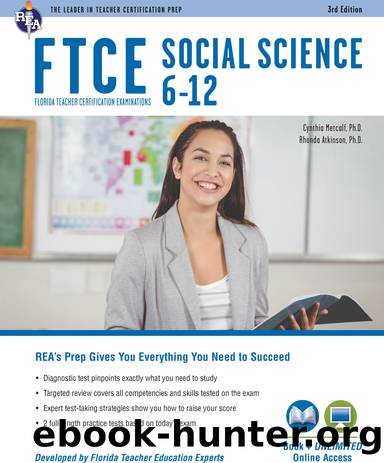FTCE Social Science 6-12 (037) Book + Online by Atkinson Rhonda;Metcalf Cynthia;

Author:Atkinson, Rhonda;Metcalf, Cynthia;
Language: eng
Format: epub
Publisher: Research & Education Association
Published: 2017-08-15T00:00:00+00:00
COMPETENCY 5.3
Identify the causes, significant individuals, and effects of the events associated with the Revolutionary era.
Albany Plan of Union
In 1754, representatives of seven colonies and 150 Indians met in Albany, New York, to gain the allegiance of the Iroquois Confederacy and to provide a system for the collective defense of the colonies in the face of the coming war with France. After renewing the alliance with the Iroquois, who promised to continue to protect the English from attacks by the French-supporting Hurons, Benjamin Franklin proposed the Albany Plan of Union. This plan provided for an intercolonial government that would regulate dealings with the Native Americans, organize and run a colonial army, manage the public lands, legislate, and supervise the collection of taxes for a common defense fund. England rejected the proposal because they felt that a union of the colonies would make them too unmanageable. The colonies also rejected the Albany Plan because they did not want to relinquish any of their powers to a grand council, particularly the right to tax. Franklinâs annoyance at the lack of support was reflected in his published cartoon in which he drew a snake broken into pieces, with the inscription below: âJoin, or Die.â The drawing was based on the popular belief that a snake that had been cut in half would come to life again if the pieces were joined before sunset. This rejection of the Albany Plan foreshadowed what would happen later in colonial affairs and the issues that would arise in future intercolonial gatherings like the First and Second Congress. Had the Albany Plan passed, it could have rendered the American Revolution unnecessary. This also proved to be the last attempt to devise an intercolonial union.
Figure 5.2
Download
This site does not store any files on its server. We only index and link to content provided by other sites. Please contact the content providers to delete copyright contents if any and email us, we'll remove relevant links or contents immediately.
1,001 ASVAB Practice Questions For Dummies by Powers Rod(4045)
ASVAB For Dummies by Powers Rod(2465)
Police Exams Prep 2018-2019 by Kaplan Test Prep(2039)
Churchill by Paul Johnson(2016)
Wiley CPA Examination Review Focus Notes by Kevin Stevens(1617)
Wonder by R J Palacio(1609)
First Aid Handbook--Crucial Survival Skills, Emergency Procedures & Lifesaving Medical Information by Department of the Army(1508)
1936941139 (N) by Bob Rosenthal(1506)
A Very Stable Genius by Philip Rucker & Carol Leonnig(1339)
ASVAB AFQT For Dummies by Rod Powers(1322)
1,001 ASVAB AFQT Practice Questions For Dummies by Angie Papple Johnston(1178)
U.S. Army Combat Pistol Training Handbook by Army(1151)
CISSP For Dummies by Miller Gregory Peter(1140)
The GED Crash Course by Alpha(1115)
Court Officer Exam by Learning Express LLC(1067)
Master the Civil Service Exams by Peterson's(1061)
McGraw-Hill Education 2,000 Review Questions for the CPA Exam by Denise M. Stefano(1060)
Master the ASVAB by Scott Ostrow(1053)
Future Design by Unknown(1021)
